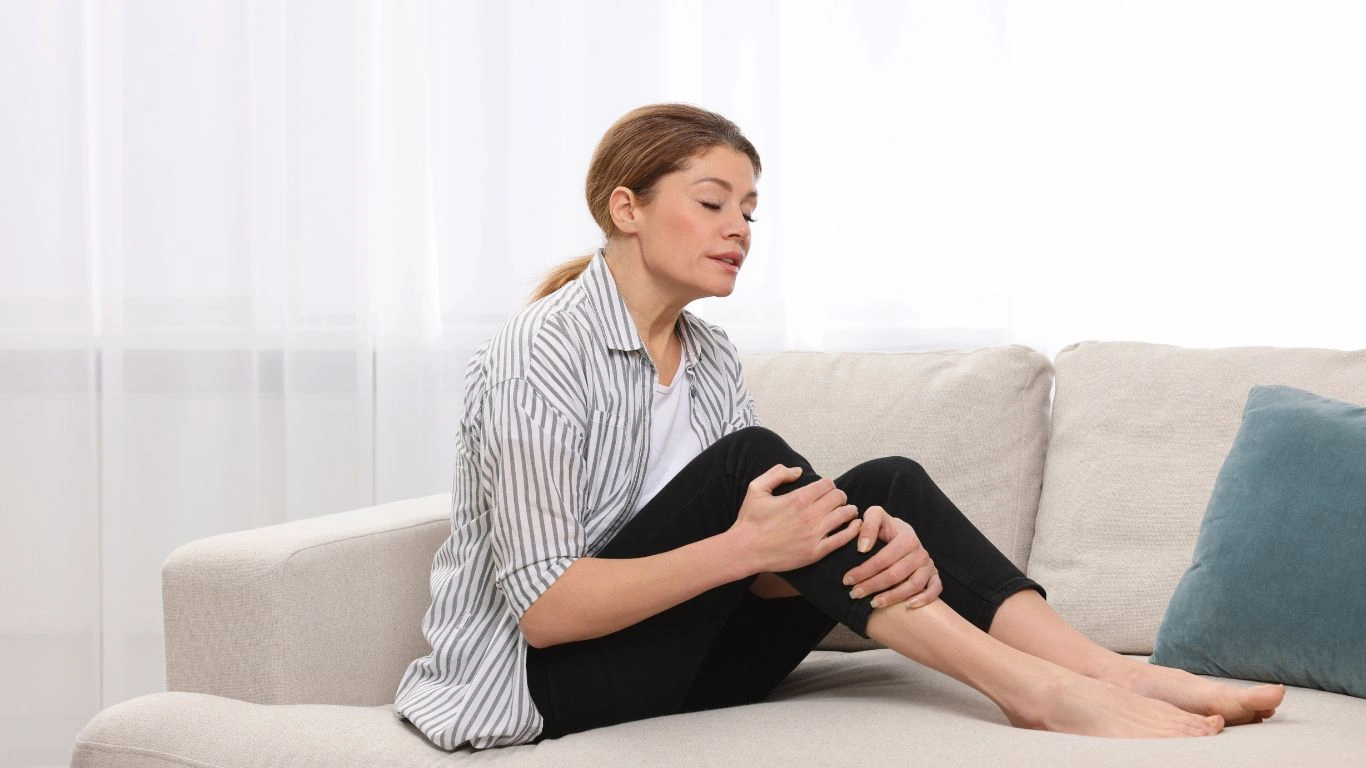“Stretching for Rheumatoid Arthritis: Unlock Joint Health Naturally”
Living with rheumatoid arthritis (RA) can be incredibly challenging, but there are ways to make daily life a bit easier and more manageable. As someone who specializes in diagnosing, treating, and managing this condition, I’ve seen firsthand how stretching and flexibility exercises can make a world of difference for RA patients. Rheumatoid arthritis isn’t just about pain and swelling in the joints — it impacts the entire body and can seriously limit your mobility. But here’s the good news: stretching can play a pivotal role in maintaining flexibility, improving strength, and enhancing overall joint function. In this article, we’ll explore the importance of stretching, the science behind it, and how it can benefit you, whether you’re newly diagnosed or have been living with RA for a while. So, let’s dive right in!
The Importance of Stretching for Rheumatoid Arthritis Patients

When we think about managing rheumatoid arthritis, the first thing that often comes to mind is medication. But did you know that one of the most effective ways to improve your quality of life with RA is something that’s completely free? That’s right — stretching! While medications can help reduce pain and inflammation, stretching is all about improving flexibility, mobility, and the function of your joints. And trust me, as someone who works with RA patients regularly, I can tell you this: incorporating stretching into your daily routine can truly help with the stiffness, joint pain, and limited range of motion that so many of us with RA experience.
The act of stretching itself is simple — it’s just about lengthening and elongating your muscles and joints to prevent them from becoming tight and stiff. And for those of us dealing with RA, tight muscles can exacerbate the discomfort that already comes from swollen and inflamed joints. It’s easy to overlook the power of stretching, but trust me, when done regularly, it can reduce pain, increase circulation, and even lower stress. But let’s dig a little deeper into why stretching is such an essential tool for managing rheumatoid arthritis.
How Stretching Helps with Joint Flexibility
One of the key ways that stretching benefits RA patients is by improving joint flexibility. If you’ve ever felt that awful feeling of being unable to fully straighten your arm or bend your knee due to stiffness, you’re not alone. RA often causes chronic inflammation in the joints, which can lead to long-term damage, including loss of flexibility. Regular stretching helps maintain the full range of motion in your joints, which can be a game-changer in your day-to-day activities.
- Stretching can help prevent further joint damage caused by restricted movement.
- It can also reduce the formation of scar tissue, which can develop when joints are immobilized for too long.
- Stretching can improve circulation around the joints, promoting healing and reducing pain.
From my experience, patients who consistently stretch report feeling more agile and capable of performing routine tasks that otherwise might feel impossible. Even simple stretches like reaching for the ceiling or gently twisting your torso can make a significant difference when done properly. And, yes, I know it can feel uncomfortable at first, especially during flare-ups, but gentle stretching has a long-lasting benefit when done consistently over time.
Stretching: A Key to Reducing Stiffness and Pain

One of the most frustrating aspects of RA is the stiffness that comes along with it, often leaving you feeling like you’re moving in slow motion. But stretching is one of the most effective ways to reduce this stiffness and discomfort. When you’re feeling stiff and achy, it’s tempting to stay still, but that often makes things worse. The key is to keep moving — even if it’s just small stretches at first.
When you stretch, you’re increasing the blood flow to your muscles and joints. This helps to loosen up tight muscles and reduces the pain associated with stiff joints. Stretching also encourages the production of synovial fluid, which lubricates the joints, allowing them to move more freely. It’s important to remember that, just like any new habit, stretching takes time to yield results, but the benefits can be noticeable almost immediately, especially in terms of decreased stiffness.
Types of Stretching for Rheumatoid Arthritis
Now, let’s talk about the different types of stretching that are particularly beneficial for RA patients. Not all stretches are created equal, so it’s essential to focus on exercises that are gentle on your joints while still providing a good stretch. Below are a few types of stretches you can incorporate into your routine to help manage RA symptoms:
- Static Stretching: This is the most common type of stretch where you hold a stretch for a period of time, typically 15-30 seconds. Static stretches help lengthen the muscles and improve flexibility.
- Dynamic Stretching: Unlike static stretching, dynamic stretches involve movement. These are best performed before activities to warm up the body. Think of leg swings or arm circles to prepare your body for the day ahead.
- PNF Stretching: Proprioceptive Neuromuscular Facilitation (PNF) involves a combination of stretching and contracting muscles. This technique is often used in physical therapy settings to improve flexibility and joint function.
Each of these types of stretching has its place in a well-rounded stretching routine, and the best part is that you can do them at home without any special equipment. If you’re unsure where to start, I always recommend beginning with gentle static stretches and then progressing to dynamic stretches as your flexibility improves. Over time, you can gradually increase the intensity and duration of your stretches — just make sure you’re listening to your body and staying within a comfortable range.
Why Consistency is Key

It’s easy to fall off the wagon when it comes to any new habit, and stretching is no exception. But the real magic happens when you commit to stretching regularly. Like most things in life, consistency is key. I’ve seen many of my patients experience the most significant improvements when they commit to daily stretching, even if it’s just for a few minutes each day.
Set a time each day to stretch, whether it’s first thing in the morning or before bed. The goal is to incorporate stretching into your daily routine so that it becomes second nature. And don’t be discouraged if you don’t feel instant relief — like any treatment for RA, it takes time. But stick with it, and you’ll likely start to notice less stiffness, better range of motion, and a reduction in joint pain as you continue stretching regularly.
How Stretching Enhances Joint Health in RA

In addition to improving flexibility, stretching has a direct impact on the overall health of your joints. With rheumatoid arthritis, the immune system mistakenly attacks the synovium, the lining of your joints, causing inflammation and pain. Over time, this can lead to the deterioration of the joints, which is why it’s so crucial to take proactive steps to preserve joint health.
One way stretching helps is by reducing inflammation around the joints. As you stretch, the muscles around the affected joints become more flexible and less tense, which can reduce the pressure on the joints themselves. Additionally, stretching can stimulate the production of synovial fluid, the lubricating fluid inside your joints, helping them to move more freely and with less discomfort. Think of it like oiling a rusty hinge – it makes everything move more smoothly!
And don’t forget that your muscles play a huge role in supporting and protecting your joints. Tight muscles can place added strain on your joints, causing even more discomfort. Stretching helps to release this tension and protect the integrity of your joints, which is essential when you’re managing RA. I’ve had several patients tell me how they felt the difference after incorporating regular stretching into their routines – their joints felt “less stiff” and “more comfortable” overall. That’s the kind of feedback I love to hear!
The Role of Stretching in Preventing RA Flare-Ups
Anyone living with rheumatoid arthritis knows that flare-ups can come out of nowhere, and when they do, they can knock you down for days or even weeks. But stretching regularly can help prevent flare-ups by keeping your muscles, tendons, and ligaments flexible and strong. This is especially true when you stretch gently and consistently, even on days when you’re not experiencing much pain. The goal is to keep everything moving and functioning as smoothly as possible.
When you stretch, you’re not only improving your flexibility and joint health, but you’re also increasing blood circulation. This enhanced circulation delivers oxygen and nutrients to the muscles, joints, and tissues, helping them recover more quickly from stress or inflammation. Over time, this can reduce the frequency and intensity of flare-ups.
In my experience, patients who are proactive with stretching report fewer flare-ups and better overall symptom management. Stretching helps reduce the buildup of tension, which can act as a trigger for flare-ups, and promotes a sense of overall well-being. So, while stretching might seem like a small step in the bigger picture of managing RA, it can actually make a significant difference in the long term. And trust me, it’s worth incorporating into your daily routine.
Stretching and Mental Well-Being

Managing the physical aspects of rheumatoid arthritis is one thing, but let’s not forget about the mental toll it can take on you. Chronic pain, fatigue, and limited mobility can all contribute to feelings of frustration, anxiety, and depression. But there’s good news – stretching can also help improve your mental well-being. It’s not just about the physical benefits; stretching has a calming effect on the mind and body.
When you stretch, you’re engaging in a mindful activity that encourages you to focus on your body and breath. This mindfulness aspect of stretching can reduce stress and promote relaxation, helping you manage the emotional side of living with RA. In fact, research has shown that regular physical activity, including stretching, can help reduce symptoms of anxiety and depression in people with chronic conditions like rheumatoid arthritis.
Incorporating stretching into your routine can help boost your mood and make you feel more in control of your body. Over time, you’ll notice that you’re not only managing your symptoms better but also feeling more empowered and less overwhelmed by the condition. It’s these small wins that help maintain a positive outlook as you navigate the challenges of living with rheumatoid arthritis.
Stretching Safely: Tips for RA Patients
While stretching is incredibly beneficial, it’s important to do it safely, especially when you’re managing a condition like rheumatoid arthritis. RA affects everyone differently, so it’s crucial to listen to your body and modify stretches to suit your personal needs. Here are some tips I always recommend to my patients when it comes to stretching safely:
- Start Slowly: If you’re new to stretching or haven’t stretched in a while, start with gentle stretches and gradually increase the intensity. Avoid pushing your body too hard, especially if you’re experiencing a flare-up.
- Warm Up First: Before stretching, always take a few minutes to warm up your body with light movement like walking or gentle cycling. This helps prepare your muscles for stretching and reduces the risk of injury.
- Focus on Form: Proper form is essential when stretching. Avoid bouncing or jerking movements, which can cause injury. Instead, hold each stretch for 15-30 seconds and focus on breathing deeply as you stretch.
- Be Gentle on Sensitive Joints: Some joints may be more sensitive than others. For example, if you have wrist or knee pain, be mindful of how much pressure you put on those areas. Use props like cushions or pillows to support your joints if needed.
Remember, you don’t have to stretch like an athlete or push yourself to the limit. The goal is to keep your muscles and joints flexible, not to achieve perfect form. If you’re unsure about a specific stretch or feel uncomfortable, it’s always a good idea to consult with your doctor or a physical therapist. They can help you design a personalized stretching routine that’s tailored to your needs and limitations.
Stretching as Part of a Holistic RA Management Plan

While stretching is a powerful tool in managing rheumatoid arthritis, it’s just one piece of the puzzle. I always tell my patients that RA management is most effective when it’s approached from a holistic perspective. In addition to stretching, it’s important to incorporate other healthy habits into your lifestyle, such as:
- Healthy Nutrition: Eating a balanced diet rich in anti-inflammatory foods can help manage RA symptoms. Foods like fatty fish, leafy greens, and nuts provide essential nutrients that support joint health.
- Strengthening Exercises: Incorporating strength training into your routine can help improve muscle strength, which in turn supports your joints and reduces stress on them.
- Rest and Recovery: While activity is important, it’s equally essential to allow your body to rest and recover. Overexertion can lead to flare-ups, so be sure to listen to your body’s signals.
- Medication Management: Working with your healthcare team to find the right medication plan is crucial for reducing inflammation and managing pain.
Stretching, combined with these other practices, forms the foundation of a comprehensive RA management plan that can significantly improve your quality of life. As always, make sure to consult with your healthcare provider before making changes to your routine or starting new exercises. They can guide you in making the best choices based on your individual health needs.
Incorporating Stretching into Your Daily Routine

At this point, you’re probably feeling motivated to start stretching regularly — and you should be! But one of the common challenges many people with rheumatoid arthritis face is simply finding the time or energy to commit to a stretching routine. Between managing work, family, and your RA symptoms, it can sometimes feel like there’s not enough time in the day. However, incorporating stretching into your daily routine doesn’t have to be complicated or time-consuming. In fact, small adjustments can make a huge difference, and it’s about consistency rather than perfection.
When I work with my patients, I emphasize making stretching a daily habit. Here are a few tips on how to easily incorporate stretching into your day-to-day routine:
- Stretch First Thing in the Morning: Start your day off with a gentle stretching routine to loosen up your muscles and joints. This can help reduce morning stiffness and set a positive tone for the rest of the day.
- Stretch During Breaks: If you work at a desk or spend long periods sitting, make it a habit to take breaks every hour and stretch for a few minutes. This can prevent your muscles from becoming too tight and help relieve any tension from sitting for long periods.
- Set a Reminder: Life can get busy, and it’s easy to forget. Set an alarm or reminder on your phone to prompt you to stretch at a certain time each day, whether it’s in the morning, during lunch, or before bed.
- Incorporate Stretching into Other Activities: If you’re already doing other activities like walking or yoga, try to integrate stretches at the end of your routine. For example, after a short walk, take a few minutes to stretch your hamstrings, calves, and hips.
Once stretching becomes a regular part of your routine, you’ll start to see the benefits — less stiffness, improved mobility, and a greater sense of control over your body. Just remember that it’s okay to start slow. Your body will thank you for even the smallest efforts.
Managing RA Flare-Ups with Stretching and Movement

One of the most challenging aspects of living with rheumatoid arthritis is the unpredictable nature of flare-ups. They can happen without warning, and during these times, even the thought of moving or stretching may feel daunting. But here’s where the beauty of a stretching routine really comes into play. While it might seem counterintuitive, gentle movement and stretching during flare-ups can actually help reduce the severity and duration of symptoms.
When you’re dealing with a flare-up, it’s essential to take things slowly and listen to your body. Pushing through pain is never a good idea, but even during flare-ups, small stretches can help maintain joint function and alleviate some discomfort. Stretching helps to release built-up tension, improves circulation, and even aids in reducing muscle spasms that often accompany RA flare-ups.
It’s important to focus on the following when stretching during a flare-up:
- Be Gentle: Keep the intensity low, and opt for gentle, slow stretches that don’t push your joints too far. Avoid any movements that feel sharp or painful.
- Focus on Relaxation: Deep breathing can help calm your nervous system and reduce the stress response that can make flare-ups worse. Pairing breathing techniques with your stretches can provide immediate relief.
- Limit the Duration: If you’re in the middle of a flare-up, it’s important not to overdo it. Short, frequent stretching sessions throughout the day are more beneficial than one long stretch.
Through my years of experience working with RA patients, I’ve seen that even on the worst flare-up days, gentle movement and stretching can make a world of difference. It helps to keep your muscles engaged, your joints lubricated, and your mental health in check. By committing to a gentle stretching routine, even during flare-ups, you may experience a reduction in inflammation and a quicker recovery time.
The Power of Staying Active Alongside Stretching
While stretching is incredibly beneficial for RA patients, it’s even more effective when combined with other forms of low-impact exercise. Staying active is one of the best things you can do for your joints, as it helps to strengthen the muscles around them and reduce the risk of stiffness. It also promotes joint health by maintaining your range of motion and flexibility.
In addition to stretching, here are some forms of exercise that work particularly well for individuals with rheumatoid arthritis:
- Walking: Walking is a great low-impact exercise that keeps your joints moving without causing excess strain. Even a short daily walk can help improve flexibility and reduce stiffness.
- Swimming: The buoyancy of water supports your body, taking pressure off your joints while providing a full-body workout. Swimming is fantastic for RA patients because it provides both cardio and strength benefits without added stress on your joints.
- Yoga: Yoga combines gentle stretching with deep breathing and relaxation techniques, making it a perfect activity for managing RA. Many yoga poses are specifically designed to help improve joint mobility and strengthen muscles without causing strain.
- Biking: Cycling, especially on a stationary bike, is another low-impact exercise that improves joint flexibility and endurance. Plus, it’s an excellent way to get your heart pumping without risking injury.
When you combine stretching with these forms of exercise, you create a balanced routine that supports your joint health and enhances overall flexibility and strength. It’s important to find activities you enjoy, as consistency is the key to reaping the full benefits. And, of course, always consult your healthcare provider before starting any new exercise program to ensure it’s appropriate for your specific needs.
Important Considerations and Final Thoughts
Living with rheumatoid arthritis can be tough, but the good news is that there are numerous strategies you can implement to manage your symptoms and improve your quality of life. Stretching is one of the most accessible and effective tools in your RA management toolbox. It helps to keep your joints flexible, your muscles strong, and your mind calm. By making stretching a consistent part of your daily routine, you can improve your flexibility, reduce pain, and even prevent flare-ups.
However, it’s important to remember that RA is a complex condition that requires a holistic approach to management. Stretching should be combined with other lifestyle practices, such as medication management, balanced nutrition, and strength training, to get the most out of your treatment plan. Every individual’s experience with RA is different, so make sure to tailor your routine to what works best for you. And don’t hesitate to reach out to your healthcare team for personalized guidance.
Disclaimer: This article is intended for informational purposes only and should not replace professional medical advice. Always consult with your healthcare provider before making any changes to your treatment plan or exercise routine.
For more information on managing rheumatoid arthritis and the importance of stretching, visit HealthUsias.com.

Tarra Nugroho is a dedicated Nurse Practitioner with a strong foundation in family and preventive care. She brings both compassion and clinical expertise to her practice, focusing on patient-centered care and health education. As a contributor to Healthusias.com, Tarra translates medical knowledge into clear, empowering articles on topics like women’s health, chronic disease management, and lifestyle medicine. Her mission is simple: help people feel seen, heard, and informed—both in the clinic and through the content she creates. When she’s not caring for patients, Tarra enjoys weekend hikes, plant-based cooking, and curling up with a good health podcast.






